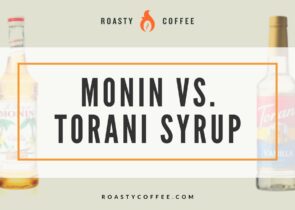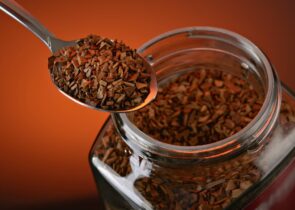If you’re new to coffee, it can be somewhat overwhelming trying to figuring out what coffee works best for you. Coffee itself is an art form that many individuals around the globe cherish, from the dedication of planting and growing it down to the latte art on your milk foam.
That being said, there are many steps involved from picking coffee off of the tree to sipping it from your cup. One of the most important parts of this process is roasting the coffee. Though there are a few different roast levels to choose from, two of the most common are light and dark roasts.
But what exactly does “light” and “dark” roasted coffee mean? What are the differences between them? Read on to find out which one is best for you!
What Does Roasting Coffee Do?
Obviously, you can’t just pluck coffee beans off of the tree and drink them. That’s why roasting comes in handy. And little known to some, coffee beans are actually not really beans–they’re seeds of the Coffea plant. These seeds are found inside what is commonly referred to as coffee cherries, a small, cherry-like fruit that hosts two seeds. Once the cherry is picked, it is then processed in order to remove the inner seeds.
After this has been successfully done, the roasting process can begin. Roasting coffee can happen in a variety of methods, combined with a variety of different flavors and aromas. This is how so many different light and dark roasted coffees are made.
Ultimately, the roasting process is designed to cook the coffee, driving out all of the moisture within the beans and allowing the inner notes of flavor to be coaxed out. The roasting process is what gives coffee it’s “coffee” taste, and it plays an important role in every cup you sip.
What is Light Roast?
Lightly roasted coffee consists of light brown colored beans that haven’t been cooked for short amounts of time. These beans are usually roasted at lower temperatures, usually between 356-401 degrees F. While roasting, they’ll usually make a cracking noise once they reach a certain temperature–similar to the sound of popcorn popping. It’s usually after the “first crack” that the light roast is removed. And in case you aren’t familiar with coffee slang, light roast coffee is also referred to as a light city, half city, and cinnamon roast.
What is Dark Roast?
On the opposite end of the spectrum, dark roasted beans are dark brown, almost black, and are cooked for a longer amount of time at higher temperatures, usually around 464-482 degrees F. If the roasts go any higher than around 482 degrees, they’ll burn and ruin the flavor.
As a result, they’re usually removed around the second crack. Dark roasted coffee is oilier than lightly roasted coffee because the longer coffee beans are roasted, the more the oils inside of the beans can be drawn out to the surface. Some examples of dark roasts include French roasts, Italian roasts, and espresso.
And…Medium?
A medium roast is just what you would expect: a medium point between light roasts and dark roast coffee. Many coffee lovers enjoy it because it provides a perfect balance of acidity, flavor, etc. If you aren’t a fan of the brightness and acidity of lighter roasts, but also not a fan of dark roast, then a medium may just be the nice in-between you’re looking for.
Light Roast vs Dark Roast: The Nitty Gritty
Now that we’ve got the gist, let’s break it down further. There are several key differences between these two roasts, and knowing them will help you decide which one will best suit your taste buds.
Body & Complexity
One of the most important qualities about coffee, “body” refers to the physical properties of it. These physical properties include texture (watery, gritty, silky,) the heaviness, and the general mouthfeel of it. When it comes to light roasts, they are usually brighter in color and are lighter in body. This is primarily because the beans aren’t roasted long enough for the sugars within the beans to caramelize.
On the other hand, darker roasts are the opposite. They are deeper in color and consist of bold, robust flavor. Many coffee fans enjoy dark roast coffee because the deeper, thicker body can make it more savory to sip on. Furthermore, because they are roasted for longer amounts of time at hotter temperatures, darker roasts have more body because of the caramelized sugars from the bean.
Flavor
The longer coffee is roasted, the more the sugars inside of the beans can caramelize, creating the coffee flavor that many people enjoy. Since lighter roasts aren’t cooked at high of temperatures for a long time, they preserve much of the original coffee-bean flavor.
As a result, lighter roasts are often the greatest reflection of the different origins where the coffee beans are grown, as well as the quality of the coffee itself. This makes lighter roasts the choice of many roasters in order to measure the quality of the coffee. Where flavor is concerned, they are much more complex, ranging from possessing notes of fruity tang and citrus, sweetness, and even floral notes of flavor.
For darker roasts, the flavors usually tend to be smokier, chocolatey, and have a slightly more bitter taste than the lightly roasted coffee bean. The thin layer of oils from the dark roast beans can also be prevalent on the surface of the coffee itself. In addition to the longer, more intense roasting time, most of the unique flavors from the origin of the beans tend to be lost, with the flavors of the roast masking them.
Acidity
If you like a lot of punch in your coffee, lighter roasts may be more fitting for you. They are typically higher in acidity, primarily because the shorter roast times don’t allow the compounds within the beans to break down easily. Due to this, light roast coffee can be delicious for the taste buds but can wreak havoc if you have a sensitive stomach.
On the other hand, darker roasts are much lower in acidity, making them easier for a larger variety of people to consume. Scientists have been conducting studies that reveal that the process of roasting coffee creates a compound that can potentially help dial down the production of stomach acid in the body. Simply put: the darker the roast, the easier on the tummy.
Caffeine Content
The roasting process of coffee can also determine the amount of caffeine as well. On the lighter end of the spectrum, lighter roasts tend to have higher caffeine content because of the shorter roasting time. The caffeine remains somewhat intact, giving you a little spark with each sip of your coffee.
And of course, darker roasts tend to be the opposite. Due to the longer roasting time, the amount of caffeine that was originally present within the beans has mostly been cooked out by the time the dark roasting process is complete. So where the flavor gets smokier and deeper, the less of a risk you’ll have when it comes to upsetting your digestive system.
Roasting At Home
Though it may be a much longer process, it is possible to roast coffee in the comfort of your own home! A lighter roast may be easier to achieve since it doesn’t require as much time or as high of temperatures as dark roasts do, but a dark roast can also be achieved as long as you monitor the beans closely to prevent any accidental burning. Any burned beans will make for a gross flavor that won’t be fun to drink.
In Conclusion
There you have it: everything you need to know about light roast vs dark roast! Whether you’re a lover of light roasted coffee or dark roast, there are many coffee options out there for you to choose from! So as you’re trying out different roasts and different blends of beans, you can better navigate between which roasts work better for you.
Happy caffeinating!










